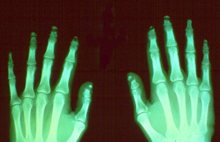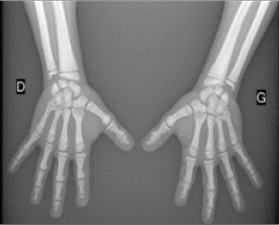Acroosteolysis

Acroosteolysis is resorption of the distal bony phalanges. Acroosteolysis has two patterns of resorption in adults: diffuse and bandlike.
The diffuse pattern of resorption has a widely diverse differential diagnosis which includes: pyknodysostosis, collagen vascular disease and vasculitis, Raynaud's neuropathy, trauma, epidermolysis bullosa, psoriasis, frostbite, sarcoidosis, hypertrophic osteoarthropathy, acromegaly, and advanced leprosy.[1][2][3]
The bandlike pattern of resorption may be seen with polyvinyl chloride exposure and Hadju-Cheney syndrome.[1]

A mnemonic commonly used for acro-osteolysis is PINCHFO.[4] Pyknodysostosis, Psoriasis, Injury (thermal burn, frostbite), Neuropathy (diabetes), Collagen vascular disease (scleroderma, Raynaud's), Hyperparathyroidism, Familial (Hadju-Cheney, progeria), Occupational (polyvinyl exposure),
Acroosteolysis may be associated with minimal skin changes or with ischemic skin lesions that may result in digital necrosis.[5]: 665
See also
References
- ↑ 1.0 1.1 Yu, Joseph. Musculoskeletal Imaging, Case Review Series. 2008.
- ↑ Romero, Belinchón; Ramos Rincón, J.M.; Reyes Rabellc, F. "Nail Involvement in Leprosy". ACTAS Dermo-Sifiliograficas. Academia Española de Dermatología y Veneralogía. Archived from the original on 28 April 2015. Retrieved 28 June 2014.
- ↑ Baran, Robert; de Berker, David A. R.; Holzberg, Mark; Thomas, Luc (July 23, 2012). Baran and Dawber's Diseases of the Nails and their Management (4th ed.). Wiley. ISBN 978-0470657355. Archived from the original on 29 April 2022. Retrieved 28 June 2014.
- ↑ http://radiopaedia.org/articles/pinch-fo Archived 2013-03-22 at the Wayback Machine[bare URL]
- ↑ Freedberg, et al. (2003). Fitzpatrick's Dermatology in General Medicine. (6th ed.). McGraw-Hill. ISBN 0-07-138076-0.